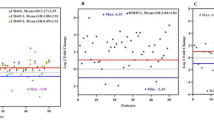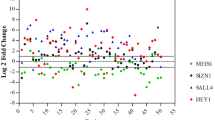Abstract
Background
Epithelial-mesenchymal transition has recently attracted great attention in studying the malignant progression of cells through a converging pathway of oncogenesis and metastasis. Twist1 and Mastermind-like 1 (MAML1) are major regulators of EMT through different pathways. The aim of this study was to investigate the clinicopathological relevance of the expression of MAML-1 and Twist1 genes in esophageal squamous cell carcinoma (ESCC).
Methods
Tumoral and corresponding normal tissues from 55 treatment-naive ESCC patients were subjected for expression analysis with quantitative real-time RT-PCR.
Results
Overexpression of MAML-1 and Twist1 were significantly associated with lymph node metastasis and the surgical staging of tumor. Overexpression of Twist1 was associated with tumor depth of invasion. Mean relative expression (MRE) of MAML1 was significantly higher in patients with metastasis to lymph nodes (3.07 ± 0.51 vs. 0.86 ± 0.58, P = .008). MRE of Twist1 was significantly higher in patients with invasion of tumor to adventitia (T3, T4) (1.97 ± 0.29 vs. 0.39 ± 0.73, P = .036). In advanced stages of tumor (stage III, IV), a significantly higher MRE of Twist1 (2.47 ± 0.41 vs. 1.25 ± 0.36, P = .035) and MAML1 (3.05 ± 0.45 vs. 1.07 ± 0.59, P = .021) mRNA was observed.
Conclusions
We introduce Twist1 and MAML1 as new molecular markers of advanced tumor, which determine the characteristics and aggressive behavior of ESCC. Along with the emerging evidence of their role in different cellular processes and aberrations in various cancers, they are suggested as potentially interesting therapeutic targets to reverse a broad spectrum of functional aberrations that promote ESCC development.


Similar content being viewed by others
References
Sasaki K, Natsugoe S, Ishigami S, Matsumoto M, Okumura H, Setoyama T, et al. Significance of Twist expression and its association with E-cadherin in esophageal squamous cell carcinoma. J Exp Clin Cancer Res. 2009;28:158.
Ansieau S, Morel AP, Hinkal G, Bastid J, Puisieux A. TWISTing an embryonic transcription factor into an oncoprotein. Oncogene. 2010;29:3173–84.
Christiansen JJ, Rajasekaran AK. Reassessing epithelial to mesenchymal transition as a prerequisite for carcinoma invasion and metastasis. Cancer Res. 2006;66:8319–26.
Klymkowsky MW, Savagner P. Epithelial-mesenchymal transition: a cancer researcher’s conceptual friend and foe. Am J Pathol. 2009;174:1588–93.
Yang J, Mani SA, Donaher JL, Ramaswamy S, Itzykson RA, Come C, et al. Twist, a master regulator of morphogenesis, plays an essential role in tumor metastasis. Cell. 2004;117:927–39.
Yuen HF, Chan YP, Wong ML, Kwok WK, Chan KK, Lee PY, et al. Upregulation of Twist in oesophageal squamous cell carcinoma is associated with neoplastic transformation and distant metastasis. J Clin Pathol. 2007;60:510–4.
Katoh M, Katoh M. Notch signaling in gastrointestinal tract (review). Int J Oncol. 2007;30:247–51.
Wu L, Griffin JD. Modulation of Notch signaling by mastermind-like (MAML) transcriptional co-activators and their involvement in tumorigenesis. Semin Cancer Biol. 2004;14:348–56.
Fiuza UM, Arias AM. Cell and molecular biology of Notch. J Endocrinol. 2007;194:459–74.
Watt FM, Estrach S, Ambler CA. Epidermal Notch signalling: differentiation, cancer and adhesion. Curr Opin Cell Biol. 2008;20:171–9.
McElhinny AS, Li JL, Wu L. Mastermind-like transcriptional co-activators: emerging roles in regulating cross talk among multiple signaling pathways. Oncogene. 2008;27:5138–47.
Koch U, Radtke F. Notch and cancer: a double-edged sword. Cell Mol Life Sci. 2007;64:2746–62.
Proweller A, Tu L, Lepore JJ, Cheng L, Lu MM, Seykora J, et al. Impaired notch signaling promotes de novo squamous cell carcinoma formation. Cancer Res. 2006;66:7438–44.
Wu L, Sun T, Kobayashi K, Gao P, Griffin JD. Identification of a family of mastermind-like transcriptional coactivators for mammalian notch receptors. Mol Cell Biol. 2002;22:7688–700.
Sobin LH. TNM Classification of Malignant Tumours. 7th edition, Chichester, U.K., Wiley-Blackwell, 2009.
Mani SA, Guo W, Liao MJ, Eaton EN, Ayyanan A, Zhou AY, et al. The epithelial-mesenchymal transition generates cells with properties of stem cells. Cell. 2008;133:704–15.
Wu L, Aster JC, Blacklow SC, Lake R, Artavanis-Tsakonas S, Griffin JD. MAML1, a human homologue of Drosophila mastermind, is a transcriptional co-activator for NOTCH receptors. Nat Genet. 2000;26:484–9.
Chen J, Imanaka N, Chen J, Griffin JD. Hypoxia potentiates Notch signaling in breast cancer leading to decreased E-cadherin expression and increased cell migration and invasion. Br J Cancer. 2009;102:351–60.
Taghavi N, Biramijamal F, Sotoudeh, M, Khademi H, Malekzadeh R, Moaven O, et al. p16INK4a hypermethylation and p53, p16 and MDM2 protein expression in esophageal squamous cell carcinoma. BMC Cancer. 2010;10:138.
Ayyanan A, Civenni G, Ciarloni L, Morel C, Mueller N, Lefort K, et al. Increased Wnt signaling triggers oncogenic conversion of human breast epithelial cells by a Notch-dependent mechanism. Proc Natl Acad Sci U S A. 2006;103:3799–804.
Li QQ, Xu JD, Wang WJ, Cao XX, Chen Q, Tang F, et al. Twist1-mediated adriamycin-induced epithelial-mesenchymal transition relates to multidrug resistance and invasive potential in breast cancer cells. Clin Cancer Res. 2009;15:2657–65.
Vincent-Salomon A, Thiery JP. Host microenvironment in breast cancer development: epithelial-mesenchymal transition in breast cancer development. Breast Cancer Res. 2003;5:101–6.
Tsuji T, Ibaragi S, Hu GF. Epithelial-mesenchymal transition and cell cooperativity in metastasis. Cancer Res. 2009;69:7135–9.
Martin TA, Goyal A, Watkins G, Jiang WG. Expression of the transcription factors snail, slug, and twist and their clinical significance in human breast cancer. Ann Surg Oncol. 2005;12:488–96.
Luo GQ, Li JH, Wen JF, Zhou YH, Hu YB, Zhou JH. Effect and mechanism of the Twist gene on invasion and metastasis of gastric carcinoma cells. World J Gastroenterol. 2008;14:2487–93.
Leong KG, Niessen K, Kulic I, Raouf A, Eaves C, Pollet I, et al. Jagged1-mediated Notch activation induces epithelial-to-mesenchymal transition through Slug-induced repression of E-cadherin. J Exp Med. 2007;204:2935–48.
Kalluri R, Weinberg RA. The basics of epithelial-mesenchymal transition. J Clin Invest. 2009;119:1420–8.
Yang Z, Zhang X, Gang H, Li X, Li Z, Wang T, et al. Up-regulation of gastric cancer cell invasion by Twist is accompanied by N-cadherin and fibronectin expression. Biochem Biophys Res Commun. 2007;358:925–30.
Kogan-Sakin I, Tabach Y, Buganim Y, Molchadsky A, Solomon H, Madar S, et al. Mutant p53(R175H) upregulates Twist1 expression and promotes epithelial-mesenchymal transition in immortalized prostate cells. Cell Death Differ. 2011;18:271–81.
Yang MH, Hsu DS, Wang HW, Wang HJ, Lan HY, Yang WH, et al. Bmi1 is essential in Twist1-induced epithelial-mesenchymal transition. Nat Cell Biol. 2010;12:982–92.
Wang X, Ling MT, Guan XY, Tsao SW, Cheung HW, Lee DT, et al. Identification of a novel function of TWIST, a bHLH protein, in the development of acquired taxol resistance in human cancer cells. Oncogene. 2004;23:474–82.
Shiota M, Yokomizo A, Itsumi M, Uchiumi T, Tada Y, Song Y, et al. Twist1 and Y-box-binding protein-1 promote malignant potential in bladder cancer cells. BJU Int. 2011;108:E142–9.
Sanchez-Garcia I. The crossroads of oncogenesis and metastasis. N Engl J Med. 2009;360:297–9.
Acknowledgment
The authors gratefully acknowledge the review of our manuscript by Mr. Danial Afsharzadeh. The authors are also thankful to Ezzat Dadkhah, Azadeh A’rabi, and Martha Ghahraman at the Division of Human Genetics for their technical assistance. Additionally, we appreciate all our colleagues at the departments of Surgery and Pathology at Omid Hospital for their help in gathering and preparing tissue specimens. This study was supported by a grant (No. 51423880299007) from Islamic Azad University, Damghan Branch, Damghan, Iran.
Author information
Authors and Affiliations
Corresponding author
Rights and permissions
About this article
Cite this article
Forghanifard, M.M., Moaven, O., Farshchian, M. et al. Expression Analysis Elucidates the Roles of MAML1 and Twist1 in Esophageal Squamous Cell Carcinoma Aggressiveness and Metastasis. Ann Surg Oncol 19, 743–749 (2012). https://doi.org/10.1245/s10434-011-2074-8
Received:
Published:
Issue Date:
DOI: https://doi.org/10.1245/s10434-011-2074-8




